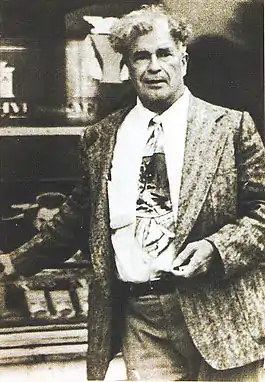Hiski Salomaa
Hiski Salomaa (born Hiskias Möttö; May 17, 1891 – July 7, 1957) was a Finnish-American singer and songwriter.[1]
Hiski Salomaa[1] | |
|---|---|
 "The Finnish Woody Guthrie" | |
| Born | Hiskias Möttö May 17, 1891 |
| Died | July 7, 1957 (aged 66) |
| Occupation | singer, songwriter, tailor, restaurateur |
| Spouse(s) | Aini Saari |
Life
Born in Kangasniemi, Salomaa immigrated to the United States in 1909 following the death of his mother. He then moved to Michigan's Upper Peninsula, where he made his living as a tailor. An advocate of syndicalism, he joined the Industrial Workers of the World and served time in prison as a conscientious objector during the First World War.[1]
Salomaa's depiction of Finnish immigrant life was very popular among the Finnish diaspora. An interesting feature of his writing was the use of Finglish, making his lyrics difficult to understand outside of a Finnish-American or Finnish-Canadian setting.[1] Referred to as the Finnish Woody Guthrie,[2] Salomaa's songs portrayed the immigrant experience of working-class Finns.[3]
Hella Wuolijoki, the head of Yleisradio in Finland in the late 1940s, once broke a Hiski Salomaa record into pieces during a live broadcast because she so hated the song "Lännen lokari".[4]
Legacy
Between 1927 and 1931 Salomaa recorded eighteen sides for Columbia Records.[5] His best-known songs included "Tiskarin polkka" (Dishwasher's Polka), "Vapauden kaiho" (Yearning for Freedom), and "Lännen lokari" (The Western Logger). Salomaa's recordings are considered an important part of Finnish recording history because during this period the recording industry was almost non-existent in Finland. In fact, in the years from 1917 through 1925 not a single record was released in the country.[1]
Since the 1970s, Hiski Salomaa's recordings have been reissued in both analog and digital formats.[6][7][8] In 1992 his song "Värssyjä sieltä ja täältä" (Verses from Here and There) was published in Mel Bay’s Immigrant Songbook, an American songbook with lyrics in both Finnish and English.[9]
References
- Hiski Salomaa. fi.wikipedia.org. Retrieved: March 13, 2013.
- Siirtolaisten Woody Guthrie. palasokeri.com. Retrieved: March 13, 2013.
- A Passion For Polka: Old-Time Ethnic Music In America by Victor R. Greene, (Berkeley : University of California Press, 1992) pp. 109-110.
- Lännen Lokari fi.wikipedia.org. Retrieved: April 26, 2015.
- Ethnic Music On Records by Richard K. Spottswood, (University of Illinois Press, 1990) Volume 5, pp. 2596-2597.
- Värssyjä sieltä ja täältä (Helsinki: Love Records, 1971).
- Hiski Salomaa: Kootut teokset 1927–1931 (Helsinki: Johanna, 1991).
- Stranded in the USA (Munich: Trikont, 2004).
- Mel Bay’s Immigrant Songbook by Jerry Silverman, (Pacific, MO: Mel Bay Publications, 1992).
External links
Photos
- Salomaa grave in Vehmaa
- Hiski Salomaa biography 2011
- Salomaa memorial in Kangasniemi
- Hiski and Aina visit Kangasniemi 1952
- Hiski Salomaa at the Institute of Migration
Videos
Streaming audio